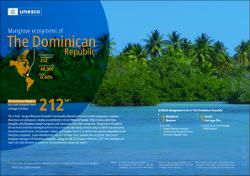| Author | United Nations Educational, Scientific and Cultural Organization (UNESCO) | |
| Accessioned date | 2023-02-28T23:58:33Z | |
| Available date | 2023-02-28T23:58:33Z | |
| Year | 2022 | |
| Citation | United Nations Educational, Scientific and Cultural Organization (UNESCO) (2022). Mangrove ecosystems of The Dominican Republic. Paris: Unesco. Recuperado de: | es |
| URI | https://bvearmb.do/handle/123456789/2378 | |
| Abstract | This poster contains information about the mangrove ecosystems of the Dominican Republic. The La Selle - Jaragua-Bahoruco-Enriquillo Transboundary Biosphere Reserve includes mangrove ecosystems. Mangroves are widespread, notably around Monte Cristi and Bahia de Samaná. There is also a saline lake, Enriquillo, with Rhizophora mangle mangroves and Conocarpus erectus back-mangroves. Mangroves in this part of the world are sometimes damaged by hurricanes or extreme tidal waves, however, they are also known to recover from these natural events. Coastal oyster, lobster, and snapper fisheries, as well as tour-operators depend on intact mangrove ecosystems. Coastal development, just as in so many places globally, has caused the reduction of mangrove coverage in The Dominican Republic. Listing the UNESCO Biosphere Reserve in 2017 was one important step in the right direction: to revert to a harmony between people and nature | es |
| Language | English | es |
| Published | Paris: Unesco | es |
| Rights | © United Nations Educational, Scientific and Cultural Organization (UNESCO). | es |
| Subject | Recursos naturales - República Dominicana | es |
| Subject | Biodiversidad - República Dominicana | es |
| Subject | Hábitats y especies | es |
| Subject | Áreas protegidas - República Dominicana | es |
| Subject | Reservas de la biosfera | es |
| Title | Mangrove ecosystems of The Dominican Republic | es |
| URL | https://unesdoc.unesco.org/ark:/48223/pf0000382164 | |
| Material type | Infographic - Poster | es |
| Type of content | Cultural or scientific information | es |
| Access | Open | es |
| Audience | General | es |
| Audience | Technicians, professionals and scientists | es |


